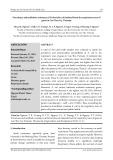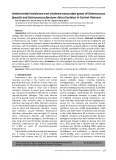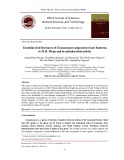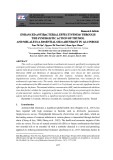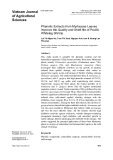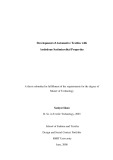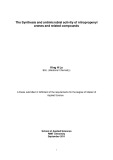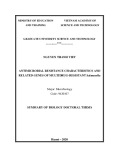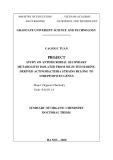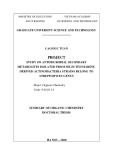doi:10.1111/j.1432-1033.2004.04219.x
Eur. J. Biochem. 271, 2841–2852 (2004) (cid:3) FEBS 2004
Peroxidase catalyzed nitration of tryptophan derivatives Mechanism, products and comparison with chemical nitrating agents
Alberto Sala, Stefania Nicolis, Raffaella Roncone, Luigi Casella and Enrico Monzani
Dipartimento di Chimica Generale, Universita` di Pavia, Italy
4-nitro, 6-nitro, 7-nitro and N1-nitro derivatives follows a similar trend, indicating that they are formed according to a similar mechanism, the ratio between the N1-nitroso deriv- ative and other derivatives depends markedly on the nitrite concentration when tryptophan modification is performed by the peroxidase/H2O2/nitrite systems. Analysis of the data indicates that at low nitrite concentration the enzymatic reaction occurs through the classical peroxidase cycle. At high nitrite concentration the reaction proceeds through a different intermediate that we assume to be a protein bound peroxynitrite species.
Keywords: heme proteins; nitration; peroxidases; peroxy- nitrite; tryptophan.
The enzymatic nitration of tryptophan derivatives by oxi- dation of nitrite has been studied using lactoperoxidase and horseradish peroxidase, and compared with the chemical nitration produced by nitrogen dioxide and peroxynitrite. HPLC, mass spectra and NMR analysis of the mixture of products clearly show that nitration occurs at position 4-, 6-, 7-, and N1 of the indole ring, and nitrosation at position N1. –/H2O2 sys- Kinetic studies performed on peroxidase/NO2 tems showed substrate saturation behavior with all the tryptophan derivatives employed. The rate dependence on nitrite concentration was found to be linear with horseradish peroxidase while it exhibited saturation behavior with lac- toperoxidase. The composition of the product mixture depends on the nitrating agent. While the production of
Reactive nitrogen species (RNS) are formed continuously in vivo but their concentration in the body rises notably during inflammation and several pathophysiological condi- tions [1]. RNS are responsible for both nitration and oxidation of several physiological targets, in particular the amino acid residues of proteins. A wide range of putative nitrating agents have been indicated as potentially respon-
sible for the nitration reactions, and a lot of work has been carried out on their characterization. The best known nitrating agents are nitrogen dioxide (NOÆ 2), peroxynitrite [ONOO–, oxoperoxonitrate()1)], nitrous acid, nitrite and hydrogen peroxide, NOÆ and dioxygen, alkyl- and acyl- nitrates, peroxidases in the presence of nitrite and H2O2, and also different myoglobin forms in the presence of nitrite or NOÆ [1]. The presence of 3-nitrotyrosine in biological tissues has been considered as the marker of RNS accumulation. In fact, tyrosine, both as an individual amino acid [2] and as a protein residue [3,4], is nitrated by the above mentioned nitrating agents at the ortho position to its hydroxo group. Unfortunately, Tyr is not a good probe to distinguish among the different RNS involved because all of them give the same product. A more suitable nitration target to use as a probe is tryptophan, which is also present in most proteins. While it has the disadvantage of having a higher redox potential [E(cid:1)¢ (tryptophanyl radical, H+ / trypto- phan) ¼ +1.0 V] [5,6] with respect to tyrosine [E(cid:1)¢ (tyrosyl radical, H+/tyrosine) ¼ 0.9 V] [7,8], and thus it reacts less efficiently with RNS, the presence of different positions in Trp where the nitration can occur may allow its use for discrimination between the nitrating agents. In fact, Trp may be derivatized at the ring positions 2-, 4-, 5-, 6-, 7-, and also at its indole imino group. Nitrating agents may thus exhibit different regiochemistry in the reaction with Trp, and this could be useful for the discrimination of the species involved in the reaction. Relatively little is known on the derivatization of tryptophan by nitrating agents and, in the results are not homogenous and often addition, contradictory. For example, it has been reported by various research groups that: (a) the reaction of free trypto- phan with peroxynitrite produces hydroxytryptophan,
Correspondence to E. Monzani, Dipartimento di Chimica Generale, Universita` di Pavia, Via Taramelli 12, I-27100 Pavia, Italy. Fax: + 39 0382528544, Tel.: + 39 0382507331, E-mail: enrico.monzani@unipv.it Abbreviations: 1H-BB, proton broad band decoupling; DEPT(135), 13C distortionless enhancement by polarization transfer; 1H-1H DQF- COSY, double-quantum filtered 1H-1H COSY spectrum; 1H-13C HMQC, 1H-13C heteronuclear multiple quantum coherence spectrum; 1H-13C HMBC, 1H-13C heteronuclear multiple bond coherence spectrum; 4-NO2, 4-nitro-N-a-acetyl-L-tryptophan amide; 6-NO2, 6-nitro-N-a-acetyl-L-tryptophan amide; 7-NO2, 7-nitro-N-a-acetyl- L-tryptophan amide; RNS, reactive nitrogen species; ABTS, 2,2¢- azino-bis(3-ethylbenz-thiazoline-6-sulfonic acid); Ac-Trp-NH2, N-a-acetyl-L-tryptophan amide; Ac-Trp-OEt, N-a-acetyl-L-trypto- phan ethyl ester; Boc-Trp-Gly-OEt, N-a-t-Boc-L-tryptophan-glycine- ethylester; Boc-Trp-ONp, N-a-t-Boc-L-tryptophan p-nitrophenyl ester; H-Gly-Oet/HCl, glycineethyl ester hydrochloride; HRP, horseradish peroxidase; LPO, lactoperoxidase; N1-NO, N1-nitroso- N-a-acetyl-L-tryptophan amide; N1-NO2, N1-nitro-N-a-acetyl- L-tryptophan amide. Enzymes: lactoperoxidase (EC 1.11.1.7); horseradish peroxidase (EC 1.11.1.7). (Received 19 February 2004, revised 10 May 2004, accepted 17 May 2004)
2842 A. Sala et al. (Eur. J. Biochem. 271)
(cid:3) FEBS 2004
Materials and methods
Materials
N-formylkinurenine, dihydroxytryptophan, and 6-nitro- tryptophan as the only nitrated species [9]; (b) the reaction of Boc-Trp-OH with peroxynitrite produces N-formylki- nurenine, oxindole, and hydropyrroleindole and no signifi- cant nitrated residues [10]; (c) the same reaction yields 5- and (d) 6-nitrotryptophan without any hydroxylation [11]; treating Cu,Zn-superoxide dismutase with peroxynitrite (in the presence of CO2) gives Trp nitration at position 6 [12]; (e) the reaction of different forms of myoglobin with peroxynitrite generates 6-nitro, 4-nitro, and 5-nitro deriva- tives and another unidentified nitrated species [13]. Also for the simple reaction of tryptophan with nitric acid in glacial acetic acid the formation of 6-nitro-Trp [14,15] or both the 2- and 6-nitro derivatives have been reported [16].
Lactoperoxidase was purified from bovine milk as described previously [7]. Horseradish peroxidase was purchased from Sigma. Ac-Trp-NH2, Ac-Trp-OEt, N-a-t-Boc-L-tryptophan p-nitrophenyl ester (Boc-Trp-ONp), and glycine ethyl ester hydrochloride (H-Gly-Oet/HCl) were obtained from Novabiochem. Hydrogen peroxide (30% solution by weight) was obtained from Aldrich. The concentration of hydrogen peroxide solution was controlled by monitoring the formation of the 2,2¢-azino-bis(3-ethylbenz-thiazoline-6- sulfonic acid) (ABTS) radical cation according to a standard method [17].
(Fig. 1) with
)1Æcm)1
Peroxynitrite was obtained by reaction between sodium nitrite and hydrogen peroxide according to the procedure described by Hughes & Nicklin [18]; the solution was purified from excess hydrogen peroxide by treatment with MnO2. The final ONOO– concentration was determined spectrophotometrically using e302 ¼ 1670 M in 0.1 M NaOH solution [19]. Nitric oxide, purified from its oxidized derivatives, was obtained by passing the gas over NaOH pellets (prepurged with vacuum-argon cycles). NOÆ 2 was obtained by air oxidation of NOÆ. All the other reagents were of the best grade available. All the buffer solutions were prepared using deionized, double distilled water.
In the present paper we report the reaction of N-a- (Ac-Trp-NH2), N-a-acetyl- acetyl-L-tryptophan amide L-tryptophan ethyl ester (Ac-Trp-OEt), and the dipeptide N-a-t-Boc-L-tryptophanyl-glycine ethyl ester (Boc-Trp- Gly-OEt) peroxide nitrite/hydrogen catalyzed by lactoperoxidase (LPO) and horseradish peroxidase (HRP), and with the biologically relevant nitrating agents nitrogen dioxide and peroxynitrite. The products containing nitro or nitroso derivatization have been separated and characterized. In particular, we found substrate modification to 4-nitro-N-a-acetyl-L-tryptophan amide (4-NO2), 6-nitro-N-a-acetyl-L-tryptophan amide (6-NO2), 7-nitro-N-a-acetyl-L-tryptophan amide (7-NO2), N1-nitroso-N-a-acetyl-L-tryptophan amide (N1-NO), and a new product assumed to be N1-nitro-N-a-acetyl- L-tryptophan amide (N1-NO2). We also found that when –/H2O2 the reaction is performed with the peroxidase/NO2 system, the ratio between N1-NO and the other deriva- tives depends markedly on nitrite concentration, indica- ting that different enzymatic mechanisms operate at low and high nitrite concentrations.
Boc-Trp-Gly-OEt was obtained by reacting Boc-Trp- ONp (1 g, 2.35 mmol) with an excess of H-Gly-Oet/HCl (656 mg, 4.7 mmol) and 982 lL triethylamine (4.7 mmol) in 30 mL of freshly distilled (over CaH2) acetonitrile for 1 h. The volume of the mixture was reduced to about 5 mL by rotary-evaporation and, after the addition of 50 mL of water, three extractions with 20 mL dichloromethane were performed. The organic phases were collected and washed twice with an equivalent volume of water. Rotary-evapor- ation to dryness of the solution gave a white solid product (250 mg, 0.64 mmol, 25% yield). 1H NMR (400 MHz, CDCl3): d ¼ 7.56 (d, J4,5 ¼ 7.7 Hz, 1H; H-4), 7.30 (d, J6,7 ¼ 8.2 Hz, 1H; H-7), 7.11 (dd, Jobs ¼ 7.3 Hz, 1H; H-5), 7.04 (dd, Jobs ¼ 8.1 Hz, 1H; H-6), 7.03 (d, 1H; H-2), 6.88 (bt, Jobs ¼ 5.3 Hz, 1H; H-N1), 5.45 (bd, 1H; CONHCH), 5.22 (s, 2H; NHCH2CO), 4.52 (bs, 1H, CONHCH2), 4.06 (m, 1H; Trp H-a), 3.82 (bs, 1H; Trp H-b), 3.23 (bs, 1H; Trp H-b¢); 2.55 (q, J ¼ 7.16 Hz, 2H; OCH2CH3), 1.35 (s, 9H; tBu), 1.02 (t, 3H; CH2CH3).
UV-Vis spectra were recorded with a Hewlett Packard HP 8452A diode array spectrophotometer. 1H and 13C NMR spectra were recorded at 25 (cid:1)C on a Bruker AVANCE 400 spectrometer, operating at 9.37 T. 1H and 13C NMR resonances were assigned through the following experiments: 1H, 13C with proton broad band decoupling (1H-BB), 13C distortionless enhancement of polarization [DEPT(135)], double-quantum filtered 1H-1H transfer COSY spectrum (1H-1H DQF-COSY), 1H-13C hetero- nuclear multiple quantum coherence spectrum (1H-13C HMQC) and 1H-13C heteronuclear multiple bond coher- ence spectrum (1H-13C HMBC).
Electrospray ionization MS spectra were acquired using a Finnigan MAT system equipped with an ion trap detector; the experiments were performed in positive ion mode. LC-MS and LC-MS/MS data were obtained with an
Fig. 1. Tryptophan derivatives. Structures of the tryptophan deriva- employed. Ac-Trp-NH2, N-a-acetyl-L-tryptophan amide; tives Ac-Trp-OEt, N-a-acetyl-L-tryptophan ethyl ester; Boc-Trp-Gly-OEt, N-a-t-Boc-L-tryptophan-glycine-ethylester.
Peroxidase catalyzed tryptophan nitration (Eur. J. Biochem. 271) 2843
(cid:3) FEBS 2004
[NO2
[H2O2] ¼ 0.8 mM,
[Ac-Trp-NH2] ¼ 0.15–8 mM,
–] ¼ 1 M;
[NO2
[NO2 [H2O2] ¼ 1.2 mM,
[H2O2] ¼ 0.8 mM,
[NO2
[Boc-Trp-Gly-Oet] ¼ 0.8 mM, –] ¼ 3–42 mM; [Ac-Trp-Oet] ¼ 8 mM, –] ¼ 6–250 mM (b) with HRP:
LCQ-DECA ion trap mass spectrometer (Thermo-Finni- gan, San Jose, CA) equipped with electrospray ionization source. The ESI conditions were as follows: capillary tube lens )25 V, source voltage temperature 250 (cid:1)C, +4.9 kV. The HPLC pump was a Spectra System P4000 and the UV-Vis detector was a Spectra System UV2000 working in a double wavelength mode (330 and 380 nm). HPLC separation of the nitration products was carried out with a Hypersil Elite C18 column (250 · 4.6 mm, 5 lm). The runs were performed with a flow rate of 0.8 mLÆmin)1 in isocratic conditions with a mixture of 15% (v/v) CH3CN/ H2O containing 0.1% (v/v) trifluoroacetic acid.
[H2O2] ¼ 0.8 mM,
–] ¼ 100 mM (b) 0.03–12 mM, with HRP: [H2O2] ¼ 1.6 mM, [Boc-Trp-Gly-Oet] ¼ 0.1–1.3 mM, [NO2 –] ¼ 450 mM; Ac-Trp-OEt ¼ [H2O2] ¼ 0.8 mM, –] ¼ 1.1 M. The 0.06–8 mM, optimized reactant concentrations in the rate vs nitrite concentration studies were as follows: (a) with LPO: –] ¼ [Ac-Trp-NH2] ¼ 10.7 mM, 4–400 mM; [H2O2] ¼ 0.8 mM, [NO2 [H2O2] ¼ 0.8 mM, [NO2 [Ac-Trp-NH2] ¼ –] ¼ 0.04–1.2 M; [Boc-Trp-Gly- 7.3 mM, [H2O2] ¼ 1.6 mM, [NO2 –] ¼ 6–1000 mM; Oet] ¼ 1.1 mM, [NO2 –] ¼ 7–1400 mM. Ac-Trp-OEt ¼ 4 mM, [H2O2] ¼ 1.2 mM, [NO2
Kinetic studies of enzymatic nitration
Reaction of peroxidase compound II with Ac-Trp-NH2
for
(a)
M,
M,
[HRP] ¼ 8.3 · 10)6
All kinetic experiments of peroxidase catalyzed nitration by nitrite/H2O2 were followed spectrophotometrically in a thermostated quartz cuvette with 1 cm path length, equipped with a magnetic stirrer, at 20.0 ± 0.1 (cid:1)C. Solutions were buffered with 200 mM sodium phosphate, pH 7.5. The substrates utilized were Ac-Trp-NH2, Boc-Trp-Gly-OEt and Ac-Trp-OEt. In a typical experiment, the solutions of substrate, enzyme (LPO or HRP) and nitrite were mixed in the cuvette and the reactions were started by addition of a concentrated H2O2 solution (final total volume 1600 lL). The reactions were monitored through the absorbance changes with time at 416 nm during the first 20–30 s. In order to reduce the disturbing effect by the absorption of excess nitrite in the near UV range, we used a longer reading wavelength with respect to the absorbance maximum of the product mixture. Due to the variation of composition of the products on varying the concentration of the reactants, the average extinction coefficient at 416 nm for the mixture of products changed correspondingly. Therefore, to trans- form the rate data from absorbanceÆs)1 into [products]Æs)1, )1Æcm)1 was used. Kinetic param- the value of e416 ¼ 3000 M eters were obtained by fitting the experimental rate curves as a function of substrate or nitrite concentrations. The reactions catalyzed by either LPO (10)7
Compound II of LPO and HRP can be prepared by mixing equimolar amounts of H2O2 and enzyme [7,20,21]. In order to eliminate the effect of the small amount of impurities, which tend to reduce compound II to the native form, the protein was first treated with a substoichiometric quantity of hydrogen peroxide and incubated until no spectral change occurred in the Soret region. Further addition of one equivalent H2O2 produced a stable compound II. The formation of compound II was monitored through the shift of the Soret band of the native enzyme to 436 nm (for LPO) and 420 nm (for HRP). The reduction of compound II by Ac-Trp-NH2 was studied by adding different amounts of Ac-Trp-NH2 to a buffered solution of compound II and reading the difference between the absorbance at 436 and 412 nm (LPO) or between 420 and 400 nm (HRP) as a function of time. The substrate was at least five-fold more concentrated than the protein. The following reagent the reduction of concentrations were used: [LPO] ¼ 4.3 · 10)6 LPO compound II: [Ac-Trp- NH2] ¼ 22–150 · 10)6 M; (b) for the reduction of HRP compound II: [Ac-Trp-NH2] ¼ 0.08–4.3 mM.
The absorbance changes with time (DA), A436–A412 for LPO and A420–A400 for HRP, were fitted with a first order equation: DA ¼ DA¥ · [1-exp(–kobs · t)] + b, kinetic where kobs is the observed first order constant for the reduction process, DA¥ is the maximum absorbance change and b is the DA value at t ¼ 0. The second order rate constant of the reaction (k3) was obtained from the slope of the graph of kobs vs [Ac-Trp-NH2].
HPLC separation of nitrated and nitrosylated Ac-Trp-NH2 derivatives
M) or HRP (10)6 M) were carried out according to the following steps, which summarize the procedures for optimization of the concentrations of two reactants when the rate dependence on the concentration of the third reactant is studied. Step 1: the peroxide concentration maximizing the reaction rate was determined first using high nitrite (100 mM for LPO and 1.1 M for HRP) and substrate concentrations (12 mM, 1.1 mM and 8 mM for Ac-Trp-NH2, Boc-Trp-Gly-OEt and Ac-Trp-OEt, respectively). Step 2: then, the dependence of the rate vs substrate concentration using high nitrite concentration (as in step 1) and [H2O2], as optimized in the previous step, was studied. Step 3: the dependence of the rate vs nitrite concentration using saturating substrate concentration, as determined in the previous step, and [H2O2] optimized as above was finally studied. When the optimized concentrations of substrate and nitrite did not fit with those used in step 1, the whole procedure was repeated with higher reagent concentrations.
[Ac-Trp-NH2] ¼ 0.3–12 mM,
HPLC chromatography was performed on a Jasco instru- ment with a MD-1510 diode array detector using a SUPELCO C18 reverse-phase column (250 · 10 mm). Elu- tion was carried out at 4.5 mLÆmin)1 in isocratic conditions with a mixture of 15% (v/v) CH3CN/H2O containing 0.1% (v/v) trifluoroacetic acid for 30 min, followed by a linear gradient of 10 min to 100% (v/v) acetonitrile containing 0.1% (v/v) trifluoroacetic acid to wash the column. Spec- trophotometric detection of the HPLC elution profile was performed in the range 200–650 nm. Ac-Trp-NH2 amide derivatives were manually collected after the detection. The
–] ¼ 50 mM;
The optimized reactant concentrations in the rate vs substrate concentration studies were as follows: (a) with LPO: [H2O2] ¼ 0.8 mM, –] ¼ 150 mM; [NO2 [Boc-Trp-Gly-Oet] ¼ 0.05–0.8 mM, [H2O2] ¼ 0.8 mM, [Ac-Trp-Oet] ¼ [NO2
2844 A. Sala et al. (Eur. J. Biochem. 271)
(cid:3) FEBS 2004
retention times were as follows: 4-NO2, 11.6 min; 6-NO2, 12.6 min; 7-NO2, 9.5 min; N1-NO, 26.5 min; N1-NO2, 28.0 min.
Reaction with ONOO–. Bolus additions of 130 lL total volume of ONOO– (33.4 mM) were made to the substrate solution contained in an open vessel (i.e. saturated with air). After each addition, the pH was controlled and readjusted to 7.5.
Large scale preparation of nitrated and nitrosylated Ac-Trp-NH2 derivatives
Reaction with NOÆ 2. Two hundred microlitres of an air/ NOÆ 2 gas mixture (about 50%) at 1 atm were slowly bubbled into the substrate solution through a gas-tight syringe.
– system. Hydrogen Reaction with the LPO/H2O2/NO2 peroxide (1.5 mM) was added to the substrate solution containing LPO (0.1 lM) and various concentrations of nitrite (4, 6, 10, 20, 40, 200 mM). The experiments were repeated both in the presence of 20 mM hydrogen carbonate or by purging all the solutions with nitrogen for at least 20 min before the addition of H2O2. Blank experiments were run in parallel in the absence of enzyme to evaluate the eventual contribution of the noncatalytic reaction.
Ac-Trp-NH2 (130 mg) were dissolved in 50 mL of 100 mM phosphate buffer, pH 7.5, at 25 (cid:1)C, containing 0.1 lM LPO. Sodium nitrite (690 mg) was added to the solution under stirring followed by five bolus additions of 1.5 mmol hydrogen peroxide. After 10 min, the solution color became pale yellow. The final mixture was desalted by HPLC; the solution was injected into the SUPELCO C18 reverse-phase column (10 · 250 mm); upon eluting with water [containing 0.1% (v/v) trifluoroacetic acid] the salts eluted in one column volume. After washing the products with another 10 column volumes, the Ac-Trp-NH2 derivatives were eluted with a fast gradient to 0.1% (v/v) trifluoroacetic acid in CH3CN (from 0 to 100% in three column volumes). In these conditions all the products coeluted; they were manually collected and rotary-evaporated to dryness under vacuum. The solid residue was dissolved in 5 mL of CH3CN/water (1 : 10, v/v) mixture, which were then divided into several portions, and subjected to several HPLC runs with the method described in the HPLC separation above. The different products were collected separately by monitoring the UV spectra of the outlet solution and then rotary- evaporated to dryness.
– system. To the Reaction with the HRP/H2O2/NO2 substrate solution containing HRP (1.0 lM) and various concentrations of nitrite (0.04, 0.2, 1 M), 1.5 mM hydrogen peroxide was added. The experiments were repeated both in the presence of 20 mM hydrogen carbonate or by purging all the solutions with nitrogen for at least 20 min before the addition of H2O2. Blank experiments were run in the absence of enzyme to assess the effect of the noncatalytic reaction.
Reaction between N1-nitroso-N-a-acetyl-L-tryptophan amide and ONOO–
N1-nitroso-N-a-acetyl-L-tryptophan amide (N1-NO) Authentic N1-nitroso-N-a-acetyl-L-tryptophan amide was prepared according to the method developed by Brown & Stevens for N-acetyl-L-tryptophan derivatives [22].
Reaction of Ac-Trp-NH2 with HNO3/CH3COOH
Bolus additions of a total volume of 150 lL solution of ONOO– (33.4 mM) were made to 3 mL solution of N1-NO (1 mM). After each addition the pH was controlled and re-adjusted to 7.5.
Reaction of N1-nitroso-N-a-acetyl-L-tryptophan amide with the LPO/H2O2 system To 3 mL solution of N1-NO (1 mM) containing LPO (0.1 lM), hydrogen peroxide (1.5 mM) was added and the solution allowed to stand under stirring for 10 min.
A solution of 120 lL of nitric acid (65%, w/w) dissolved in 1.2 mL of glacial acetic acid was added slowly, in a total time of 30 min, to Ac-Trp-NH2 (300 mg), dissolved in 6 mL of glacial acetic acid and kept under vigorous stirring at room temperature. After 2 h the solution was rotary- evaporated to dryness under vacuum. The crude mixture of products was dissolved in the minimum amount of water (3 mL) and separated by HPLC.
Results
Small scale preparation of nitrated and nitrosylated Ac-Trp-NH2 derivatives
Identification of Ac-Trp-NH2 nitration products
Treatment of tryptophan derivatives with RNS produces several modifications, from opening of the indole ring, to hydroxylation, nitrosylation and nitration of the molecules [9–13]. In the present study we focused our attention on the nitroso and nitro containing derivatives obtained upon reaction of Ac-Trp-NH2 with some RNS. The protective groups at the N- and C-terminal positions of tryptophan were used to make the substrate a more satisfactory model for Trp residues in peptides or proteins, and to remove the free amino group, which could undergo further reactions (such as formation of diazonium salt, etc.). The products absorb at longer wavelength with respect to the starting
Three millilitre samples of a 6 mM solution of Ac-Trp-NH2 were treated with several nitrating and oxidizing agents, according to the conditions reported below, in 200 mM phosphate buffer, pH 7.5 at 25.0 ± 0.1 (cid:1)C (unless other- wise stated) for 2 min. After completion of the reaction, 500 lL of the solution were injected into the HPLC apparatus with diode array detection. Integrals of the peaks corresponding to the N1-NO and N1-NO2 derivatives were evaluated through the absorbance reading at 330 nm, whereas the integrals for the peaks of the 4-NO2, 6-NO2, and, 7-NO2 derivatives were evaluated by reading at 380 nm.
Peroxidase catalyzed tryptophan nitration (Eur. J. Biochem. 271) 2845
(cid:3) FEBS 2004
identification is supported by the absorption spectra of the derivatives collected which closely resemble those of the corresponding nitro derivatives of tryptophan [13,23,24]. No significant amount of 2-nitro and 5-nitro derivatives were detected. The HPLC chromatograms show the pres- ence of two additional products with longer retention times (Fig. 2); their mass spectra show molecular peaks with m/z values of +29 and +45, respectively, with respect to Ac-Trp-NH2. After collection of the samples from HPLC elution, both these products decompose on standing in solution, reverting back to Ac-Trp-NH2. This behavior prevents their clear NMR characterization. The first elution of these two compounds has been attributed to N1-NO,
substrate, facilitating the separation and the subsequent characterization. The complexity of the product mixtures requires HPLC chromatography for the separation of the various components. The profiles of the HPLC chromato- grams of the reaction products were different (in terms of peak intensities and peak ratios) using different nitrating agents. With the eluent used in these analysis the non- nitrosylated or non-nitrated species (such as hydroxytryp- tophan, N-formylkinurenine, and dihydroxytryptophan derivatives) elute before the unreacted Ac-Trp-NH2 and were not collected. Analysis of mass and NMR spectra clearly showed the formation of 4-NO2 (Table 1), 6-NO2 (Table 2), and 7-NO2 (Table 3) derivatives (Fig. 2). The
Table 1. Spectroscopic characterization of 4-nitro-N-a-acetyl-L-tryptophan amide (4-NO2). 1H NMR (400 MHz), 13C NMR (100.6 MHz), MS (ESI) and Uv-Vis characterization data of 4-NO2.
1H NMR (CD3OD)
Technique Results
d ¼ 7.87 (dd, J5,6 ¼ 7.8, J5,7 ¼ 0.9 Hz, 1H; H-5), 7.74 (dd, J7,6 ¼ 8.1, J5,7 ¼ 0.9 Hz, 1H; H-7), 7.41
1H NMR (CD3CN)
(s, 1H; H-2), 7.24 (dd, J5,6 ¼ 7.8, J5,7 ¼ 8.1 Hz, 1H; H-6), 4.60 (dd, Ja,b ¼ 5.6, Ja,b¢ ¼ 8.7 Hz, 1H; H-a), 3.47 (ddd, Jb,b¢ ¼ 14.7, Jb,a ¼ 5.6, Jb,2 ¼ 0.7 Hz, 1H; H-b), 3.17 (ddd, Jb¢,b ¼ 14.7, Jb¢,a ¼ 8.7, Jb¢,2 ¼ 0.5 Hz 1H; H-b¢); 1.90 (s, 3H; CH3) d ¼ 9.90 (bs, 1H; H-N1), 7.85 (dd, J5,6 ¼ 7.8, J5,7 ¼ 0.7 Hz, 1H; H-5), 7.815 (dd, J7,6 ¼ 8.1, J7,5 ¼ 0.7 Hz,
13C NMR (CD3OD)
1H; H-7), 7.42 (d, J ¼ 2.7 Hz, 1H; H-2), 7.27 (dd, J6,5 ¼ 7.8, J6,7 ¼ 8.1 Hz, 1H; H-6), 6.67 (bs, 1H, NHCO), 6.36 (bs, 1H, CONH2), 5.80 (bs, 1H, CONH2), 4.48 (ddd, Ja,b ¼ 5.1, Ja,b¢ ¼ 9.3, Ja,NHCO ¼ 6.8 Hz, 1H; H-a), 3.40 (ddd, Jb,a ¼ 5.1, Jb,b¢ ¼ 14.9, Jb,2 ¼ 0.7 Hz, 1H; H-b), 3.06 (dd, Jb¢,a ¼ 9.3, Jb¢,b ¼ 14.9 Hz, 1H; H-b¢); 1.90 (s, 3H; COCH3). d ¼ 176 (CONH2), 172 (COCH3), 143 (C-4), 140 (C-7a), 129.5 (C-2), 120 (C-6), 119 (C-3a), 118 (C-7), 117.4 (C-5), 110 (C-3), 54.5 (C-a), 29.9 (C-b), 21.3 (CH3)
MS (ESI) UV-Vis (water) m/z 291.0 [M +1] kmax ¼ 400 nm
Table 2. Spectroscopic characterization of 6-nitro-N-a-acetyl-L-tryptophan amide (6-NO2). 1H NMR (400 MHz), 13C NMR (100.6 MHz), MS (ESI) and Uv-Vis characterization data of 6-NO2.
1H NMR (CD3CN)
13C NMR (CD3CN)
Technique Results
d ¼ 9.18 (bs, 1H; H-N1), 8.38 (d, J7,5 ¼ 2 Hz, 1H; H-7), 7.97 (dd, J5,4 ¼ 8.9, J5,7 ¼ 2 Hz, 1H; H-5), 7.76 (d, J4,5 ¼ 8.9 Hz, 1H; H-4), 7.48 (s, 1H; H-2), 6.73 (bd, JNH,a ¼ 6.5 Hz, 1H, NHCO), 6.44 (bs, 1H, CONH2), 5.87 (bs, 1H, CONH2), 4.60 (m, Ja,NH ¼ 2, Ja,b ¼ 5.3, Ja,b¢ ¼ 7.7 Hz, 1H; H-a), 3.27 (dd, Jb,b¢ ¼ 15, Jb,a ¼ 5.3 Hz, 1H; H-b), 3.12 (dd, Jb¢,b ¼ 15, Jb¢,a ¼ 7.7 Hz, 1H; H-b¢); 1.86 (s, 3H; CH3) d ¼ 174 (CONH2), 170 (COCH3), 143 (C-6), 134 (C-7a), 133 (C-3a), 130.5 (C-2), 119.2 (C-4), 114.4 (C-5), 112 (C-3), 108.4 (C-7), 53.7 (C-a), 27.4 (C-b), 22.4 (CH3)
MS (ESI) UV-Vis (water) m/z 291.7 [M +1] kmax ¼ 340, 375 nm
Table 3. Spectroscopic characterization of 7-nitro-N-a-acetyl-L-tryptophan amide (7-NO2). 1H NMR (400 MHz), 13C NMR (100.6 MHz), MS (ESI) and Uv-Vis characterization data of 7-NO2.
1H NMR (D2O)
Technique Results
d ¼ 7.67 (d, J6,5 ¼ 8.4 Hz, 1H; H-6), 7.41 (dd, J4,5 ¼ 5.7, J4,6 ¼ 1 Hz, 1H; H-4), 7.40 (s, 1H; H-2), 7.17 (dd,
13C NMR (D2O)
J5,4 ¼ 5.7, J5,6 ¼ 8.4 Hz, 1H; H-5), 4.64 (m, 1H; H-a), 3.60 (dd, Jb,b¢ ¼ 13.6, Jb,a ¼ 6.5 Hz, 1H; H-b), 3.38 (dd, Jb¢,b ¼ 13.6, Jb¢,a ¼ 8.4 Hz, 1H; H-b¢); 1.86 (s, 3H; CH3) d ¼ 176 (CONH2), 174 (COCH3), 139 (7, C-NO2), 135 (7a, C), 129 (2, CH), 127 (3a, C), 122 (5, CH), 122 (6, CH), 116 (3, C), 113 (4, CH), 53.1 (a, CH), 27.1 (b, CH2), 21.7 (CH3)
MS (ESI) UV-Vis (water) m/z 291.2 [M +1] kmax ¼ 375 nm
2846 A. Sala et al. (Eur. J. Biochem. 271)
(cid:3) FEBS 2004
2, air saturated peroxynitrite, and NO2
–] [NO2
containing products resulting from the reaction of Ac- Trp-NH2 with different nitrating systems to be obtained. The data are reported in Table 4. In particular, we used NOÆ + (generated by HNO3/CH3COOH) as RNS. We also used the enzymatic systems of LPO/nitrite/hydrogen peroxide and HRP/ – concentrations. nitrite/hydrogen peroxide at different NO2 With these systems, product formation depends, both in yield and composition, on nitrite concentration. Figures 3 and 4 show the change of product composition as a function of for the HRP and LPO mediated reactions, respectively. The effect of CO2 on the nitration reaction with the enzymatic systems was analyzed com- paring the product formation when the reaction solutions were kept under nitrogen gas, saturated with air or with addition of 20 mM hydrogen carbonate. No significant differences were observed.
In order to check whether N1-NO2 formation was a consequence of oxidation of N1-NO by the highly oxidizing intermediates present in solution we separately treated the latter derivatives with ONOO– and the LPO/H2O2 system. HPLC analysis did not show formation of any nitro derivative (i.e. neither nitration of the ring nor at N1 indole position), instead, only some Ac-Trp-NH2 production was noted due to partial release of NO+ from the N-nitroso group [25–28]; this indicates that the N1 nitro derivatization is obtained directly from Ac-Trp-NH2.
Kinetic study of the reaction of Ac-Trp-NH2, Boc-Trp-Gly-OEt and Ac-Trp-OEt with the peroxidase/NO2
–/H2O2 systems
the mass
because it has the same mass (m/z ¼ 274.9 [M + H]+) and Uv-Vis (kmax ¼ 335 nm, water) spectra, the same HPLC retention time, and coelutes with a freshly prepared, authentic sample of this compound [22]. The rapid trans- formation of the N1-NO derivatives into Ac-Trp-NH2 is due to the known fast denitrosylation in acidic media of N-nitroso tryptophan derivatives [25–28], which in our case is caused by the need to use trifluoroacetic acid in the eluent for HPLC separation. We assume that the other, slow eluting compound, is the N1-NO2 derivative, due to the similarity of behavior to the N1-NO derivative; this is also spectrum (m/z ¼ 291.7 consistent with [M + H]+), the decomposition in acidic media, and the known ability of peroxynitrite and other RNS to form N-nitramines [29]. The Uv-Vis spectrum of N1-NO2 in water shows a maximum at 332 nm.
The HPLC analysis also permitted an estimate of the the various nitroso and nitro
relative amounts of
To gain information on the nitration mechanism promoted –/H2O2 systems we analyzed the by the peroxidase/NO2 reaction using three tryptophan derivatives. During the reaction the solution color turns yellow due to the formation of the nitro and nitroso tryptophan derivatives described above. This allows one to follow the progress of the reaction spectrophotometrically. In a preliminary study, we found that working with 0.1 lM LPO and 1 lM HRP the nonenzymatic derivatization of tryptophan derivatives is completely negligible during the observation times, there-
Fig. 2. Separation of nitrated and nitrosylated products of Ac-Trp-NH2 by HPLC. HPLC elution profile, with the absorbance reading at 380 nm, for the LPO catalyzed nitration of Ac-Trp-NH2. The attri- bution of the peaks is shown. The reaction was performed in the –] ¼ following conditions: [LPO] ¼ 0.1 lM, [H2O2] ¼ 1.5 mM, [NO2 0.2 M, [Ac-Trp-NH2] ¼ 6 mM for 2 min in 200 mM phosphate buffer, pH 7.5 at 25.0 ± 0.1 (cid:1)C.
Table 4. Formation of tryptophan derivatives with various nitrating systems. Peak areas (in arbitrary units) in the HPLC chromatograms of the products obtained by reacting Ac-Trp-NH2 with various nitrating agents. Peak areas were evaluated through the absorbance readings at 380 nm for 7-NO2, 4-NO2 and 6-NO2, and 330 nm for N1-NO and N1-NO2.
N1-NO Reacting agent 7-NO2 4-NO2 6-NO2 N1-NO2 (N-NO2)/(N1-NO)
21700 5080 b 3560 368 b
–] ¼ 0.04 M –] ¼ 0.2 M –] ¼ 1.0 M –] ¼ 0.004 M –] ¼ 0.006 M –] ¼ 0.01 M –] ¼ 0.02 M –] ¼ 0.04 M –] ¼ 0.20 M
a Nitration also observed at position 5 of Ac-Trp-NH2; with reading at 380 nm the peak area was 7000. b Not observed or negligible.
620 75 6770 31 75 185 57 108 157 186 139 137 1222 123 3610 121 300 693 129 242 320 396 553 545 5010 530 12800 477 1260 2930 452 689 1000 1410 2150 2200 159 1770 30500 97 114 160 380 596 2700 307 895 2170 312 435 597 998 1510 1540 0.16 0.07 – 1.93 0.51 0.07 3.22 3.81 3.73 2.63 2.53 0.57 NOÆ 2 ONOO– HNO3/CH3COOHa HRP/H2O2/[NO2 HRP/H2O2/[NO2 HRP/H2O2/[NO2 LPO/H2O2/[NO2 LPO/H2O2/[NO2 LPO/H2O2/[NO2 LPO/H2O2/[NO2 LPO/H2O2/[NO2 LPO/H2O2/[NO2
Peroxidase catalyzed tryptophan nitration (Eur. J. Biochem. 271) 2847
(cid:3) FEBS 2004
analysis shows that product composition is affected by the initial nitrite concentration. Thus, to obtain precise rate data the knowledge of the product pattern at each nitrite concentration used would be required. At the reading wavelength of 416 nm, the absorption intensity of the products 4-NO2, 6-NO2, 7-NO2, N1-NO and N1-NO2, obtained from Ac-Trp-NH2, is 94, 67, 35, 14, and 2% of their maximum wavelength, respectively. In order to simplify the treatment, a constant e-value similar to that of nitrotyrosine at 420 nm [30] was assumed as an approximation. This drastic approximation is justified considering that the relative ratios of the various products, with the only exception of N1-NO, vary only slightly in the different experiments (see below). Another complication of the study is that in the enzymatic nitration each reactant affects the rate in a way that depends on the concentration of the others. For this reason, it was found to be convenient to vary the concentration of one reagent while maintaining the concentration of the other reagents to the constant value that maximizes the rate.
[HRP] ¼ 1.0 lM, [H2O2] ¼ 1.5 mM,
thus obtaining the kcat, K Trp
furthermore,
The dependence of the rate of HRP and LPO nitration of tryptophan substrates vs hydrogen peroxide concentra- tion exhibits a bell shaped behavior, with enzyme inactivation at relatively high peroxide concentration (data not shown). The dependence of the reaction rates on the substrate concentration was found to follow a saturation behavior. Figures 5A and 6A show the data for Ac-Trp- NH2 with HRP and LPO, respectively. It is possible to apply the Michaelis–Menten approach in the analysis of the reaction rate, M and kcat=K Trp M values (Table 5). Precisely, the values refer to the nitrite concentration employed; the enzyme turnover number is underestimated because, during the catalytic cycle, part of the enzyme is presum- ably involved in the unproductive transformation of nitrite into nitrate [30].
[NO2
Fig. 3. Formation of NO-tryptophan and NO2-tryptophan derivatives –/H2O2 system. Dependence on nitrite concentration by the HRP/NO2 of the peak areas (in arbitrary units) in the HPLC chromatograms of –/ the products obtained by reacting Ac-Trp-NH2 with the HRP/NO2 H2O2 system. The peak areas were evaluated by reading the absorb- ance at 380 nm for 7-NO2, 4-NO2 and 6-NO2, and at 330 nm for N1- NO and N1-NO2. The reactions were performed in the following conditions: [Ac-Trp-NH2] ¼ 6 mM for 2 min in 200 mM phosphate buffer, pH 7.5 at 25.0 ± 0.1 (cid:1)C.
The situation is different when the dependence of the rate on nitrite concentration is analyzed at saturating substrate and hydrogen peroxide concentrations. With HRP the reaction rates depend linearly on nitrite concentration (up to 1.5 M) for all substrates (Fig. 5B shows Ac-Trp-NH2, as an example). From the slope of the straight line, the second order rate constant knitrite turnover for the reaction catalyzed by HRP could be obtained (Table 6). With LPO the reaction rates for all substrates depend on nitrite concentration with –] above 100 mM, a a bell shaped behavior. At reduction of the rate is observed. The importance of this effect depends on the substrate employed: it is larger with Boc-Trp-Gly-OEt, while it is reduced with Ac-Trp-NH2 –]) linear (Fig. 6B). From the slope of the initial (low [NO2 –] plot, the second order rate constant part of the rate vs [NO2 knitrite turnover for the reaction catalyzed by LPO was obtained (Table 6).
[LPO] ¼ 0.1 lM, [H2O2] ¼ 1.5 mM,
Reaction of peroxidase compound II with Ac-Trp-NH2
into [products]Æs)1
fore the kinetic measurements were performed using these enzyme concentrations. A detailed study of the reaction rates is complicated because the transformation of the rate data from absorbanceÆs)1 requires knowledge of the extinction coefficient of the mixture of products at the observation wavelength; but the HPLC
For HRP the redox potentials for the one-electron reduction of compound I and compound II intermediates were evaluated around 0.9 V at pH 7.0 [31–34]. In the case of LPO, these potentials are still unknown, but estimates based on rate constants indicated a potential higher than 1.0 V for the compound I/compound II
Fig. 4. Formation of NO-tryptophan and NO2-tryptophan derivatives –/H2O2 system. Dependence on nitrite concentration by the LPO/NO2 of the peak areas (in arbitrary units) in the HPLC chromatograms of –/ the products obtained by reacting Ac-Trp-NH2 with the LPO/NO2 H2O2 system. The peak areas were evaluated by reading the absorb- ance at 380 nm for 7-NO2, 4-NO2 and 6-NO2, and at 330 nm for N1-NO and N1-NO2. The reactions were performed in the following conditions: [Ac-Trp-NH2] ¼ 6 mM for 2 min in 200 mM phosphate buffer, pH 7.5 at 25.0 ± 0.1 (cid:1)C.
2848 A. Sala et al. (Eur. J. Biochem. 271)
(cid:3) FEBS 2004
–/H2O2 system. Fig. 5. Nitration rate of Ac-Trp-NH2 by the HRP/NO2 –/ Dependence of the nitration rate of Ac-Trp-NH2 with the HRP/NO2 –] ¼ H2O2 system on: (A) Ac-Trp-NH2 concentration, with [NO2 1.0 M, concentration, with [Ac-Trp-NH2] ¼ 7.3 mM, in 0.2 M phosphate buffer, pH 7.5 at 25 (cid:1)C. The concentra- tions [HRP] ¼ 1 lM, and [H2O2] ¼ 1.6 mM were used. The transfor- mation of the rate data from absorbanceÆs)1 into [products]Æs)1 was )1Æcm)1 for the performed using the constant value of e416 ¼ 3000 M product mixture.
–/H2O2 system. Fig. 6. Nitration rate of Ac-Trp-NH2 by the LPO/NO2 –/ Dependence of the nitration rate of Ac-Trp-NH2 with the LPO/NO2 –] ¼ H2O2 system on: (A) Ac-Trp-NH2 concentration, with [NO2 150 mM, and (B) nitrite concentration, with [Ac-Trp-NH2] ¼ 10.7 mM, in 0.2 M phosphate buffer, pH 7.5, at 25 (cid:1)C. The concen- trations [LPO] ¼ 0.1 lM, and [H2O2] ¼ 0.8 mM were used. The transformation of the rate data from absorbanceÆs)1 into [products]Æs)1 )1Æcm)1 for was performed using the constant value of e416 ¼ 3000 M the product mixture.
and (B) nitrite
Discussion
Chemical nitration of tryptophan and, more generally, indole derivatives is usually performed with HNO3/H2SO4 or HNO3/CH3COOH and occurs through the highly +). The reaction produces reactive nitronium ion (NO2 various nitration isomers at the indole ring positions and, with electron rich indoles, also multinitrated products or oligomers [38]. Treating Ac-Trp-NH2 with HNO3/ CH3COOH we found that each of the ring positions 4–7 of the indole nucleus can be nitrated (Table 4), but there is no evidence for the formation of either the 2-nitro deriv- ative, N1-NO or N1-NO2. It cannot be excluded that the last two compounds (particularly N1-NO2) are formed by + but are quickly hydrolyzed because of the strong NO2 acidic conditions [25–28].
Little is known on the regiochemistry of Trp nitration by physiologically important nitrating agents, namely
couple and a value around 0.9 V for the compound II/ iron(III) couple [20]. Both intermediates are able to react with indole derivatives [20]. While the rate constant for the reaction of the HRP and LPO active species with nitrite are known (Table 6) [21,30,35,36], only a few data are available in the literature on the rate constants for the reaction with tryptophan derivatives (Table 6) [20], and none with the substrates employed in this study. Indole derivatives act as one-electron reducing agents for both compound I and compound II; the rate constants for the reduction of the former intermediate (k2) are larger than those of compound II (k3). Herein, we determined the rate constants for reduction of LPO and HRP compound II by the representative substrate Ac- Trp-NH2, obtaining the values of k3 ¼ 25 ± 5 and )1Æs)1, respectively, at pH 7.5 and 25 (cid:1)C. 8.2 ± 0.3 M These values fall in the range of k3 values reported by Jantschko et al. [20] for the same enzymes and related tryptophan derivatives.
Peroxidase catalyzed tryptophan nitration (Eur. J. Biochem. 271) 2849
(cid:3) FEBS 2004
)1Æcm)1 for the product mixture.
–]
Table 5. Kinetic data for the enzymatic nitration of of tryptophan derivatives. Kinetic parameters for the peroxidase dependent tryptophan nitration –/H2O2 in 0.2 M phosphate buffer pH 7.5 at 25 (cid:1)C. The transformation of the rate data from absorbanceÆs)1 into [products]Æs)1 was by NO2 performed using the constant value of e416 ¼ 3000 M
Derivative [enzyme] (lM) [H2O2] (mM) [NO2 (M) kcat (s)1) K Trp M (mM) kcat/K Trp M )1Æs)1) (M
HRP
Ac-Trp-NH2 Ac-Trp-OEt Boc-Trp-Gly-OEt 1.0 1.0 1.0 1.6 1.2 0.8 1.00 1.1 0.45 4.3 ± 0.1 2.5 ± 0.1 1.5 ± 0.2 4.8 ± 0.3 1.5 ± 0.2 1.0 ± 0.1 860 ± 30 1600 ± 100 1400 ± 100 LPO
compound I þ Ac-Trp-NH2
ð4Þ
! compound II þ Ac-Trp-NHþÆ 2
ð5Þ
! Ac-Trp-NHþÆ
compound II þ Ac-Trp-NH2 þ 2Hþ 2 þ Fe(III) þ H2O
)1Æcm)1 for the product mixture.
Ac-Trp-NH2 Ac-Trp-OEt Boc-Trp-Gly-OEt 0.1 0.1 0.1 0.8 0.8 0.8 0.15 0.10 0.05 19 ± 1 14.5 ± 0.5 16 ± 1 2.3 ± 0.4 0.72 ± 0.07 0.26 ± 0.05 8000 ± 900 20000 ± 2000 62000 ± 7000
)1Æs)1)
Table 6. Kinetic data for the enzymatic nitration of triptophan deriva- tives. Second order rate constant for the dependence on nitrite of –/H2O2 in 0.2 M peroxidase catalyzed tryptophan nitration by NO2 phosphate buffer pH 7.5 at 25 (cid:1)C. The transformation of the rate data from absorbanceÆs)1 into [products]Æs)1 was performed using the constant value of e416 ¼ 3000 M
In addition, compound I and compound II of HRP and compound II of LPO react with nitrite producing NOÆ 2 [21,30,35,36]:
Ac-Trp-OEt Boc-Trp-Gly-OEt (M Ac-Trp-NH2
compound I þ NO(cid:6)
2 þ Hþ ! compound II þ NOÆ
2 ð6Þ
2, peroxynitrite and the peroxidase/NO2
compound II þ NO(cid:6)
2 þ 2Hþ ! Fe(III) þ NOÆ
2 þ H2O
ð7Þ
Among the various products of Trp nitration, N1-NO is most sensitive to the reagent employed (Table 4). It formally derives from Ac-Trp-NH2 by substitution of an H+ of the N-H group with NO+. It may be formed by ONOO– by direct nucleophilic nitrosation according to the reaction:
ð8Þ
Ac-Trp-NH2 þ ONOO(cid:6) ! N1 (cid:6) NO þ HOO(cid:6)
A similar reaction has been observed on secondary amines [29] and resembles S-nitrosoglutathione formation by peroxynitrite [41]. N1-NO formation by NOÆ 2 is probably connected to the presence of N2O4, by dimerization of NOÆ 2:
NOÆ –/H2O2 systems [9–13]. We found that treatment of Ac-Trp-NH2 with these reagents yields five main nitroso and nitro deriva- tives: 4-NO2, 6-NO2, 7-NO2, N1-NO, and N1-NO2. Positions 2 and 5 of the indole ring seem to be unaffected. + is The absence of a 5-nitro derivative indicates that NO2 not involved in the reactions. As shown in Table 4, product yields depend on the nitrating agent used. The relative ratios between 4-NO2, 6-NO2, 7-NO2 and N1-NO2 derivatives scarcely depend on the above men- tioned nitrating reactants (excluding HNO3/CH3COOH). Figures 3 and 4 show that even the progressive growth of –/H2O2 systems, their formation with the peroxidase/NO2 when increasing the nitrite concentration, is similar. This clearly indicates that a similar mechanism is involved, which is most probably the coupling of NOÆ 2 with a tryptophanyl radical:
2NOÆ
ð9Þ
N2O4
(cid:6)! 2 (cid:6)
Ac-Trp-NHþÆ
2 þ NOÆ
2 ! nitrated-Ac-Trp-NH2 þ Hþ
ð10Þ
Ac-Trp-NH2 þ N2O4 ! N1 (cid:6) NO þ Hþ þ NO(cid:6) 3
ð1Þ
where nitrated-Ac-Trp-NH2 represents any of the 4-NO2, 6-NO2, 7-NO2 and N1-NO2 species.
In fact, N2O4, both in the symmetrical and asymmetrical ! tautomers (O2N-NO2 ON-NO3), reacts with amines producing nitrosated and nitrated products [29,42,43].
All physiologically relevant nitrating agents are able to 2 and tryptophanyl radical. In fact, peroxynitrite
form NOÆ [39,40]:
Ac-Trp-NH2 þ ONOO(cid:6) þ 2Hþ
! Ac-Trp-NHþÆ
ð2Þ
2 þ NOÆ
2 þ H2O
NOÆ
The enzymatic nitration of Ac-Trp-NH2 exhibits a peculiar behavior, because the relative amount of N1-NO with respect to the other products depends on nitrite concentration (Table 4, Figs 3 and 4). This observation strongly suggests that the reaction mechanism changes upon –]. The peroxidase intermediates are formed increasing [NO2 by fast reaction of the enzymes with hydrogen peroxide:
ð3Þ
ð11Þ
peroxidase þ H2O2 ! compound I þ H2O(fast)
2 [5,6,37]: Ac-Trp-NH2 þ NOÆ
2 ! Ac-Trp-NHþÆ
2 þ NO(cid:6) 2
and the peroxidase intermediates can perform one-electron oxidation of indole derivatives [20]:
Compound I can react in one-electron processes with Ac-Trp-NH2, through reaction (4), or nitrite according to
HRP LPO 2.61 ± 0.07 260 ± 20 0.82 ± 0.02 900 ± 100 3.0 ± 0.6 1700 ± 300
2850 A. Sala et al. (Eur. J. Biochem. 271)
(cid:3) FEBS 2004
)1Æs)1)
Table 7. Second order rate constants for the reactions of peroxidase intermediates with nitrite and indole derivatives.
–
–
2
–
–
Reference Intermediate Substrate Product k (M
2
reaction (6). The resulting compound II derivative can in turn react with another Ac-Trp-NH2 molecule or with nitrite through reactions (5) or (7), respectively. The redu- cing agent for compound I and compound II depends on the concentration of the two substrates and their relative rate constants for the reactions with the enzyme inter- mediates.
reaction of LPO compound I with nitrite in the unpro- ductive process should become dominant and result in a significant decrease in the observed rates and product formation, in contrast with the experimental observations (Fig. 4). The decrease in the observed turnover rates (Fig. 6B) is small and is probably due to the change in the extinction coefficient with product composition, as N1-NO and N1-NO2 absorb at shorter wavelength than the other nitrated products. Furthermore, the (cid:2)quenching(cid:3) effect of nitrite in the LPO cycle hardly fits with the larger kcat value observed with LPO with respect to HRP, as reported in Table 5.
An alternative pathway is provided by an enzyme generated peroxynitrite species, as recently proposed for eosinophil peroxidase, myeloperoxidase [44], HRP and LPO [45]. This is formed by coordination of nitrite to the iron(III) center followed by reaction with hydrogen perox- ide, and can nitrate a molecule of protein-bound substrate, according to the reaction sequence:
Fe(III) þ NO(cid:6)
ð12Þ
Fe(III)-NO(cid:6) 2
(cid:6)! 2 (cid:6)
Fe(III)-NO(cid:6)
ð13Þ
2 þ H2O2 (cid:6)! FeN(O)OO þ H2O
In the case of HRP, the data in Table 7 show that compound I prefers to react with nitrite, while compound –], so that II prefers to react with Ac-Trp-NH2 at low [NO2 in these conditions the two HRP intermediates generate both NOÆ 2 and tryptophanyl radical, which rapidly couple according to reaction (1). At higher nitrite concentration, both HRP intermediates react with nitrite forming NOÆ 2 which may then react with Ac-Trp-NH2 or form N2O4. The latter reaction becomes more important as the NOÆ 2 concentration increases and this may account for the –]. How- increased production of N1-NO at higher [NO2 ever, this hypothesis is contrasted by the observation of a clear substrate saturation behavior at high nitrite concen- tration with all substrates (Figure 5A), which is difficult to account for if the active enzyme species react only with nitrite. Furthermore, the linear dependence of the reaction –] rate (Fig. 5B) and N1-NO formation (Fig. 3) with [NO2 do not agree with the bimolecularity of reaction (9).
! FeN(O)OO þ Ac-Trp-NH2
½FeN(O)OO-Ac-Trp-NH2(cid:9) ð14Þ
ð15Þ
½FeN(O)OO-Ac-Trp-NH2(cid:9) ! Fe(III) þ products
– is the peroxidase–nitrite complex, where, Fe(III)-NO2 FeN(O)OO the iron-bound peroxynitrite, [FeN(O)OO– Ac-Trp-NH2] the complex between the latter species and Ac-Trp-NH2, and (cid:2)products(cid:3) represents the mixture of 4-NO2, 6-NO2, 7-NO2, N1-NO, and N1-NO2 generated by the reaction.
This mechanism competes with the process involving the classical peroxidase intermediates. The latter mechanism –], i.e. close to physiological conditions, dominates at low [NO2 where reaction (12) is largely shifted to the left. When the nitrite concentration is increased, the importance of reac- tions (12–15) also increases. The effect is more pronounced for LPO, which has higher affinity for nitrite (Kb ¼ )1) [30], and is )1) [30] than HRP (Kb ¼ 1.3 M 22.0 ± 0.5 M at the origin of the saturation curve for nitration by LPO
In the case of LPO, compound I is highly reactive with both Trp derivatives and nitrite (Table 7), but its reaction – produces nitrate [21] and is therefore unpro- with NO2 ductive for the present mechanism. This means that for LPO compound I only reaction (4) is productive. For LPO compound II, with the reactant concentrations used, the reaction with nitrite (to give NOÆ 2) is largely preferred. The observation that knitrite turnover (Table 6) is smaller than the second order rate constant for the reaction of LPO compound II with nitrite is accounted for by the unproductive nitrate formation during the catalytic turn- –] the nitration by over of the enzyme. Thus, at low [NO2 LPO is ruled by reaction (1), as for HRP, but with an interesting reversal of substrate preference by the enzyme –] also increases the forma- intermediates. Increasing [NO2 tion rate of NOÆ 2 which, through dimerization to N2O4, accounts for the increased N1-NO production (Fig. 4). But, also with LPO, the simple mechanism through the classical peroxidase intermediates cannot adequately des- –] the cribe the data. In fact, upon further increase of [NO2
HRP compound I HRP compound I HRP compound I HRP compound I HRP compound II HRP compound II LPO compound I LPO compound I LPO compound I LPO compound I LPO compound II LPO compound II NOÆ 2 tryptophan+Æ tryptamine+Æ N-acetyltryptamine+Æ NOÆ 2 Ac-Trp-NH þ Æ – NO3 tryptophan+Æ tryptamine+Æ N-acetyltryptamine+Æ NOÆ 2 Ac-Trp-NH þ Æ 6.7 · 105 51 ± 4 88 ± 6 3800 ± 200 6.6 ± 0.4 8.2 ± 0.3 (cid:10) 2 · 107 (2.4 ± 0.1) · 104 (4.8 ± 0.1) · 105 (1.5 ± 0.1) · 106 3.5 · 105 25 ± 5 [35] [20] [20] [20] [30] This work [21] [20] [20] [20] [21] This work NO2 Tryptophan Tryptamine N-acetyltryptamine NO2 Ac-Trp-NH2 NO2 Tryptophan Tryptamine N-acetyltryptamine NO2 Ac-Trp-NH2
Peroxidase catalyzed tryptophan nitration (Eur. J. Biochem. 271) 2851
(cid:3) FEBS 2004
10. Kato, Y., Kawakishi, S., Aoki, T., Itakura, K. & Osawa, T. (1997) Oxidative modification of tryptophan residues exposed to peroxy- nitrite. Biochem. Biophys. Res. Commun. 234, 82–84.
11. Padmaya, S., Ramazenian, M.S., Bounds, P.L. & Koppenol, W.H. (1996) Reaction of peroxynitrite with L-tryptophan. Redox Report 2, 173–177.
12. Yamakura, F., Matsumoto, T., Fujimura, T., Taka, H., Muray- ama, K., Imai, T. & Uchida, K. (2001) Modification of a single tryptophan residue in human Cu,Zn-superoxide dismutase by peroxynitrite in the presence of bicarbonate. Biochim. Biophys. Acta 1548, 38–46.
13. Herold, S., Shivashankar, K. & Mehl, M. (2002) Myoglobin scavenges peroxynitrite without being significantly nitrated. Biochemistry 41, 13460–13472.
14. Phillips, R.S. & Marmorstein, R.Q. (1988) 6-Nitro-L-tryptophan: a novel spectroscopic probe of trp aporepressor and human serum albumin. Arch. Biochem. Biophys. 262, 337–344.
15. Moriya, T., Hagio, K. & Yoneda, N. (1975) A facile synthesis of 6-chloro-D-tryptophan. Bull. Chem. Soc. Jpn 48, 2217–2218. 16. Phillips, J. & Cohen, L.A. (1988) Synthesis of 2-nitro-L-trypto- phan. Heterocyclic Chem. 25, 191–192.
(Fig. 6B) and the straight line for nitration by HRP (Fig. 5B) in the rate vs nitrite concentration plots. Reaction (14) emphasizes the need of binding the Trp derivative at the peroxidase active site to make nitration efficient. This step agrees with the saturation behavior observed when the nitration rates are studied as a function of the concentration of Trp derivatives (Figs 5A and 6A). In the absence of bound substrate, the FeN(O)OO species rapidly yields nitrate. Because the reaction occurs on the bound substrate, the regiochemistry of the nitration depends on substrate dispo- sition in the active site, and can be different from what is observed with free peroxynitrite. This justifies the lack of CO2 effect on product formation at any nitrite concentra- tion. A similar effect has been observed for tyrosine nitration [30]. Unfortunately, the strong absorption of the nitration products in the near UV-Vis region makes it impossible to follow the enzyme features during turnover and to obtain direct information on the enzyme species involved in the key step of the catalytic cycle. In spite of this, our data indicate that besides compound I and compound II inter- mediates, a peroxidase generated nitrating agent, which we propose to be a protein bound peroxynitrite species, is also involved in the enzymatic reaction. A similar intermediate was invoked for the peroxidase catalyzed nitration of tyrosine [30,45].
17. Redaelli, C., Monzani, E., Santagostini, L., Casella, L., Sanang- elantoni, A.M., Pierattelli, R. & Banci, L. (2002) Characterization and peroxidase activity of a myoglobin mutant containing a distal arginine. Chembiochem. 3, 226–233. 18. Hughes, M.N. & Nicklin, H.G.
(1970) Chemistry of peroxonitrites. II. Copper (II)-catalyzed reaction between hydroxyl- amine and peroxonitrite in alkali. J. Chem. Soc. 925–928.
Acknowledgements
19. Hughes, M.N. & Nicklin, H.G. (1968) Chemistry of pernitrites. I. Kinetics of decomposition of pernitrous acid. J. Chem. Soc. 450–452.
This work was supported by the Italian MURST, through a PRIN Project, the Italian CNR, through the target project on (cid:2)Biotechnology(cid:3), and by the European INTAS and COST programmes.
References
20. Jantschko, W., Furtmu¨ ller, P.G., Allegra, M., Livrea, M.A., Jakopitsch, C., Regelsberger, G. & Obinger, C. (2002) Redox intermediates of plant and mammalian peroxidases: a comparative transient-kinetic study of their reactivity toward indole derivatives. Arch. Biochem. Biophys. 398, 12–22.
21. Bru¨ ck, T.B., Fielding, R.J., Symons, M.C.R. & Harvey, P.J. (2001) Mechanism of nitrite-stimulated catalysis by lactoper- oxidase. Eur. J. Biochem. 268, 3214–3222. 1. Ischiropoulos, H. (1998) Biological tyrosine nitration: a patho- physiological function of nitric oxide and reactive oxygen species. Arch. Biochem. Biophys. 356, 1–11.
22. Brown, T.B. & Stevens, M.F.G. (1975) Confirmation of the site of nitrosation in tryptophan derivatives by a-chymotrypsin. J. Chem. Soc. Perkin Trans. I, 2357–2360. 23. Da Settimo, A. (1962) 4- and 7-nitrotryptophan. Ann. Chim. 52, 17–24. 24. De Fazi, R., Berti, G. & Da Settimo, A. (1959) 6-Nitrotryptophan. Gazz. Chim. Ital. 89, 2238–2257. 2. van der Vliet, A., Eiserich, J.P., Halliwell, B. & Cross, C.E. (1997) Formation of reactive nitrogen species during peroxidase-cata- lyzed oxidation of nitrite. A potential additional mechanism of nitric oxide-dependent toxicity. J. Biol. Chem. 272, 7617–7625. 3. Sampson, J.B., Ye, Y.Z., Rosen, H. & Beckman, J.S. (1998) Myeloperoxidase and horseradish peroxidase catalyze tyrosine nitration in proteins from nitrite and hydrogen peroxide. Arch. Biochem. Biophys. 356, 207–213.
25. Bonnett, R. & Nicolaidou, P. (1979) Nitrosation and nitrosylation of hemoproteins and related compounds. Part 2. The reaction of nitrous acid with the side chains of a-acylamino-acid esters. J. Chem. Soc. Perkin Trans. I, 1969–1974. 4. Eiserich, J.P., Hristova, M., Cross, C.E., Jones, A.D., Freeman, B.A., Halliwell, B. & van der Vliet, A. (1998) Formation of nitric oxide-derived inflammatory oxidants by myeloperoxidase in neu- trophils. Nature 391, 393–397.
26. Meyer, T.A., Williams, D.L.H., Bonnett, R. & Ooi, S.L. (1982) Denitrosation of N-acetyl-N1-nitrosotryptophan in acid solution. J. Chem. Soc. Perkin Trans. II, 1383–1387. 5. Butler, J., Land, E.J., Pru¨ tz, W.A. & Swallow, A.J. (1982) Charge transfer between tryptophan and tyrosine in proteins. Biochim. Biophys. Acta 705, 150–162.
6. Jovanovic, S.V. & Steenken, S. (1992) Substituent effects on the spectral, acid-base, and redox properties of indolyl radicals: a pulse radiolysis study. J. Phys. Chem. 96, 6674–6679. 27. Castro, A., Iglesias, E., Leis, J.R., Pen˜ a, M.E., Tato, J.V. & Williams, D.L.H. (1986) Kinetics and mechanism of the nitro- the denitrosation of sation of N-acetyltryptophan and of N-acetyl-N1-nitrosotryptophan. J. Chem. Soc. Perkin Trans. II, 1165–1168.
7. Monzani, E., Gatti, A.L., Profumo, A., Casella, L., & Gullotti, M. (1997) Oxidation of phenolic compounds by lactoperoxidase. Evidence for the presence of a low-potential compound II during catalytic turnover. Biochemistry 36, 1918–1926. 8. Harriman, A. (1987) Further comments on the redox potentials of tryptophan and tyrosine. J. Phys. Chem. 91, 6102–6104.
28. Mellet, P.O., Noel, P.R. & Goutefongea, R. (1986) Nitrite tryp- tophan reaction: evidence for an equilibrium between tryptophan and its nitrosated form. J. Agric. Food. Chem. 34, 892–895. 29. Masuda, M., Mower, H.F., Pignatelli, B., Celan, I., Friesen, M.D., Nishino, H. & Hohshima, H. (2000) Formation of N-nitrosamines and N-nitramines by the reaction of secondary amines with peroxynitrite and other reactive nitrogen species: comparison with nitrotyrosine formation. Chem. Res. Toxicol. 13, 301–308. 9. Alvarez, B., Rubbo, H., Kirk, M., Barnes, S., Freeman, B.A. & Radi, R. (1996) Peroxynitrite-dependent tryptophan nitration. Chem. Res. Toxicol. 9, 390–396.
2852 A. Sala et al. (Eur. J. Biochem. 271)
(cid:3) FEBS 2004
biological nitrogen-containing cyclic molecules by a radical path- way, as demonstrated by ultraweak luminescence coupled with ESR technique. Biochem. Biophys. Res. Commun. 259, 460–464. 30. Monzani, E., Roncone, R., Casella, L., Galliano, M. & Koppenol, W.H. (2004) Mechanistic insight into the peroxidase catalyzed nitration of tyrosine derivatives by nitrite and hydrogen peroxide. Eur. J. Biochem. 271, 895–906.
40. Pietraforte, D. & Minetti, M. (1997) One-electron oxidation pathway of peroxynitrite decomposition in human blood plasma: evidence for the formation of protein tryptophan-centred radicals. Biochem. J. 321, 743–750. 31. Yamada, H. & Yamazaki, I. (1974) Proton balance in conversions between five oxidation-reduction states of horseradish peroxidase. Arch. Biochem. Biophys. 165, 728–738.
32. Nakajima, R. & Yamazaki, I. (1987) The mechanism of oxyper- oxidase formation from ferryl peroxidase and hydrogen peroxide. J. Biol. Chem. 262, 2576–2581. 41. van der Vliet, A., Hoen, P.A., Wong, P.S., Bast, A. & Cross, C.E. (1998) Formation of S-nitrosothiols via direct nucleophilic nitrosation of thiols by peroxynitrite with elimination of hydrogen peroxide. J. Biol. Chem. 273, 30255–30262.
33. Hayashi, Y. & Yamazaki, I. (1979) The oxidation-reduction potentials of compound I/compound II and compound II/ferric couples of horseradish peroxidases A2 and C. J. Biol. Chem. 254, 101–106. 42. Challis, B.C., Edwards, A., Hunma, R.R., Kyrtopoulos, S.A. & Outram, J.R. (1978) Rapid formation of N-nitrosamines from nitrogen oxides under neutral and alkaline conditions. IARC Sci. Publ. 19, 127–142. 34. Farhangrazi, Z.S., Fossett, M.E., Powers, L.S. & Ellis, W.R. study of (1995) Variable-temperature spectroelectrochemical horseradish peroxidase. Biochemistry 34, 2866–2871. 43. Challis, B.C., Outram, J.R. & Shuke, D.E.G. (1980) New path- ways for the rapid formation of N-nitrosamines under neutral and alkaline conditions. IARC Sci. Publ. 31, 43–58.
35. Roman, R. & Dunford, H.B. (1973) Horseradish peroxidase. XII. Kinetic study of the oxidation of sulfite and nitrite by compounds I and II. Can. J. Chem. 51, 588–596.
36. Gebicka, L. (1999) Kinetic studies on the oxidation of nitrite by horseradish peroxidase and lactoperoxidase. Acta Biochim. Pol. 46, 919–927. 37. Koppenol, W.H. (1998) The basic chemistry of nitrogen monoxide and peroxynitrite. Free Rad. Biol. Med. 25, 385–391. 44. Brennan, M.-L., Wu, W., Fu, X., Shen, Z., Song, W., Frost, H., Vadseth, C., Narine, L., Lenkiewicz, E., Borchers, M.T., Lusis, A.J., Lee, J.J., Lee, N.A., Abu-Soud, H.M., Ischiropoulos, H. & Hazen, S.L. (2002) A tale of two controversies: defining both the role of peroxidases in nitrotyrosine formation in vivo using eosi- nophil peroxidase and myeloperoxidase-deficient mice, and the nature of peroxidase-generated reactive nitrogen species. J. Biol. Chem. 277, 17415–17427.
38. Remers, W.A. (1972) Indoles, part one. In The Chemistry of Heterocyclic Compounds (Houlihan, W.J., ed.), pp. 78–84. John Wiley & Sons, New York.
39. Mouithys-Mickalad, A., Kohnen, S., Deby, C., Noels, A.F., Lamy, M. & Deby-Dupont, G. (1999) Peroxynitrite reacts with 45. Casella, L., Monzani, E., Roncone, R., Nicolis, S., Sala, A. & De Riso, A. (2002) Formation of reactive nitrogen species at biologic heme centers: a potential mechanism of nitric oxide- dependent toxicity. Environ. Health Perspect. 110, 709–711.








